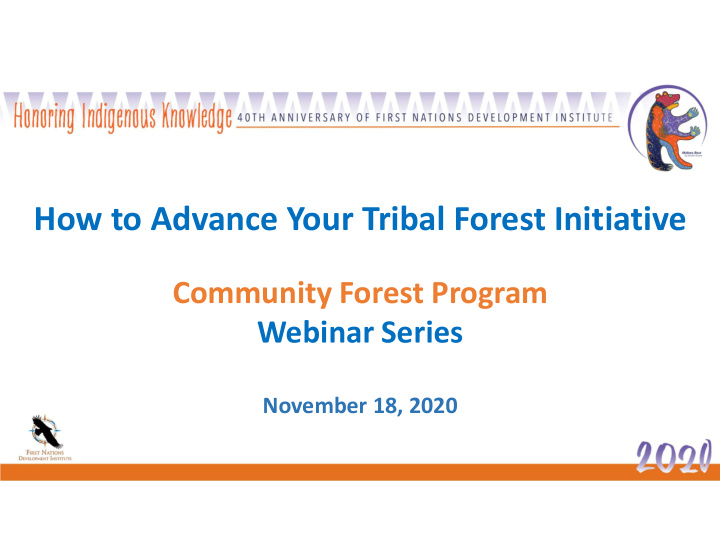



How to Advance Your Tribal Forest Initiative Community Forest Program Webinar Series November 18, 2020
Introductions Mary Adelzadeh Nausheen Iqbal Candice Polisky Ray D. Entz Program Specialist Community Forest Director, Wildlife (Diné) Cooperative Program and Terrestrial First Nations Forestry Coordinator, Resources Development Institute USDA Forest Service Western States Kalispel Tribe of Consultant USDA Forest Service Indians
For 40 years
Webinar Management All participants will be muted during the webinar Please use the question box to enter any questions to staff There will be a question and answer session at the end of the presentation. Please add your questions to the question box
Community Forest and Open Space Conservation Program
Purpose • Economic benefits • Forest Management Demonstration benefits • Environmental benefits • Recreational benefits • Educational benefits Cowee Site, Cherokee Territory in North Carolina By Matthew Timothy Bradley - Own work, CC BY-SA 4.0, https://commons.wikimedia.org/w/index.php?curid=56894863
Eligibility NUMBER OF PROJECTS FUNDED • Tribal governments • Qualified nonprofit LOCAL GOVERNMENT 37 entities (must have a conservation NON-PROFIT purpose) 38 ORGANIZATION • Local governments TRIBAL GOVERNMENT 3
Land Eligibility and Requirements Eligibility Requirements • • Threatened Private lands Provide public access • Cannot be converted into trust • Full fee purchase • 5-year self-certifying statements • At least five acres in size and occasional spot check • Suitable to sustain natural monitoring vegetation • Community forestry plan that • At least 75% forested addresses public benefits
Public Benefits • Recreation • Watershed Protection • Wildlife Habitat Protection • Timber and non-Timber Products
Why is this program important to Tribes and Native Communities? • Opportunity for Tribes to regain control and access to ancestral lands. • Restore Traditional Ecological Knowledge on the land • Forest management demonstration/Public education • Improve community access to traditional foods/resources (acorns, mushrooms, cedar, etc.) • Develop economic opportunities for hunting, timber, fishing, etc.
Eastern Band of Cherokee Indians Funded in FY12 (~108 acres) and FY20 (20 acres) Culturally and historically significant 108-acre tract
Demonstration Project • Includes a scenic hiking trail system that exhibits native plants and traditional uses of natural resources • The Cherokee actively manage the forest through traditional forest management practices. o Prescribed burning o Invasive species removal o Tree planting
Additional benefits…. • White oak regeneration on the property • Access for Native artisans to obtain the resources (non-timber forest products) needed to make their crafts • Preserve waterways, soil, and rare or threatened species.
Kalispel Tribe Indian Creek Community Forest • Funded in FY12; 350-acres • Established a Native Plant Nursery • Established a Fishing Pond • Developed an Interpretive Trail • Restored Native Trees and Shrubs
Funding Requirements • At least a 50% match with non-federal funding. • Not include borrowed funds that could encumber property. • Must use funding during the grant period.
Allowable Costs • Full fee purchase price • Appraisal/Appraisal review (following Federal standards or “yellow book”) • Land survey • Legal & closing costs • Title examination • Development of Community Forest Plan
Examples of Non-Federal Match • State Community Forest Grant Programs • Private Foundations • Land donation or Bargain Sale • In-kind Services
Partnerships for Acquisitions • The Trust for Public Land • The Conservation Fund • Nature Conservancy • Local Land Trust
Non-Allowable Costs • Conservation Easement Purchases • Long-term operation, maintenance, and land management • Construction of buildings or recreational facilitates • Research • Existing liens or taxes owed • Costs associated with preparation of the application, except any allowable project costs specified in 36 CFR 230.6(b)
Application Components • Property Information • Community Forest Establishment Information • Acquisition Information
Application Timeline August January February March April – May – 14, 2020 11, 2021 8, 2021 15, 2021 May June Selections Request for Application State Forester or Forest Service Review and announced. Proposals due to State equivalent Tribal ranking of Region/Area/II Grant Issued in Forester or Authority submit applications TF submits agreements Federal equivalent applications to eligible developed Register Tribal Forest Service applications for with Authority Region/Area/IITF national successful consideration applicants
Review Considerations • Type and extent of community benefits. • Extent and nature of community engagement. • Amount of cost share leverage. • Community forest contribution to a landscape conservation initiative. • Extent of due diligence completed on the project. • Likelihood of conversion to non-forest uses if unprotected. • Costs to the Federal government.
In Partnership with the USDA Forest Service’s Community Forestry Program, First Nations Development Institute is: • Conducting outreach to tribes and Native-led organizations • Providing technical assistance for application development • Identifying best practices for project development
Q&A Please submit your questions in the question box
Contact Information Ray D. Entz Mary Adelzadeh Director, Wildlife and Terrestrial Resources Consultant Kalispel Tribe of Indians First Nations Development Institute rentz@kalispeltribe.com madelzadeh@firstnations.org 509-447-7278 530-402-5404 Nausheen Iqbal Candice Polisky Program Specialist, Cooperative Forestry Community Forest Program Coordinator, USDA Forest Service Western States nausheen.iqbal@usda.gov USDA Forest Service 202-594-7554 candice.polisky@usda.gov 971-710-2346
Contact and Social Media First Nations Development Institute @ FirstNationsDevelopmentInstitute 2432 Main Street, 2 nd Floor Longmont, Colorado 80501 www.firstnations.org Tel: 303.774.7836 @FirstNationsDevelopmentInstitute Email: info@firstnations.org The recorded webinar can be accessed on our website under the First Nations @FNDI303 Knowledge Center at https://www.firstnations.org/fnk @FNDI303
Thank you for joining! This webinar was made possible in part by support from the USDA Forest Service. This institution is an equal opportunity provider.
Recommend
More recommend